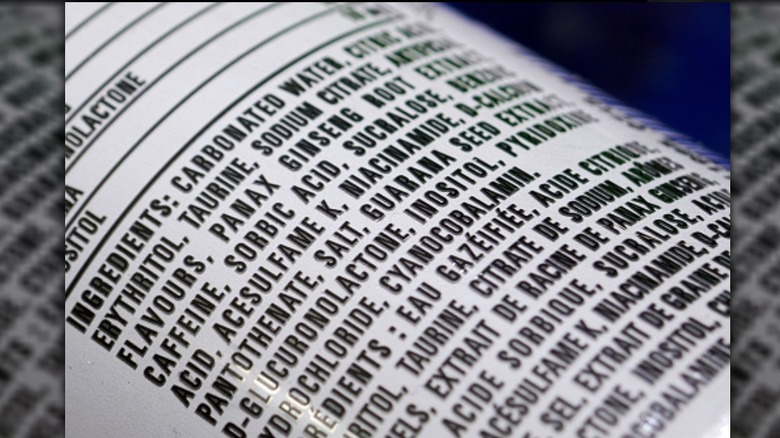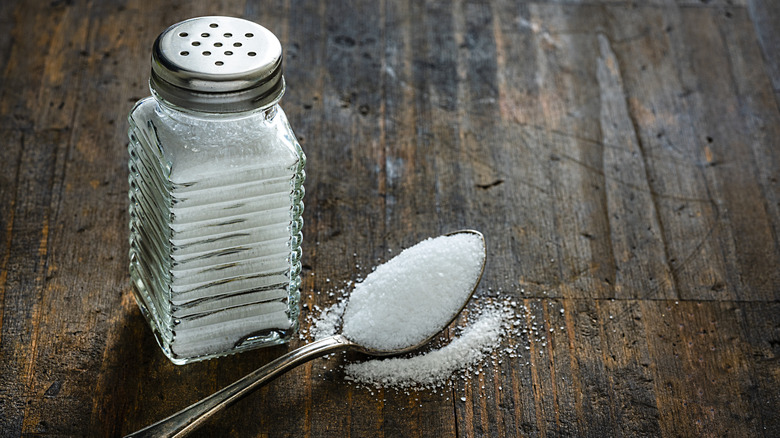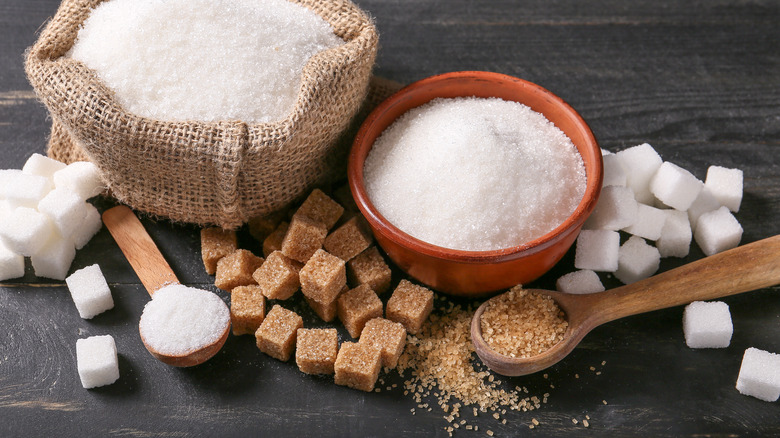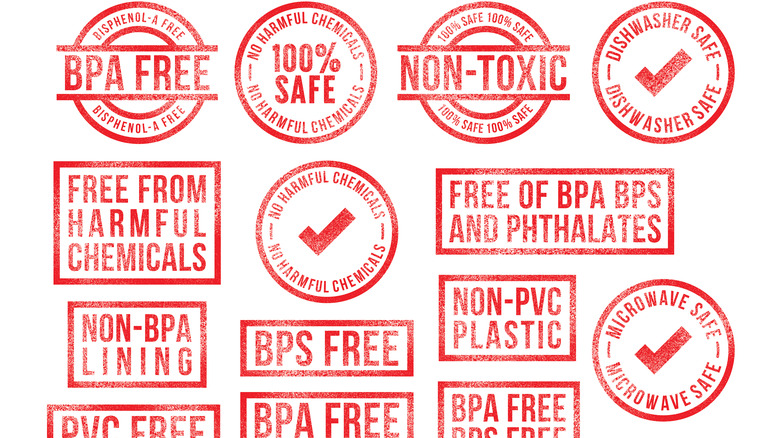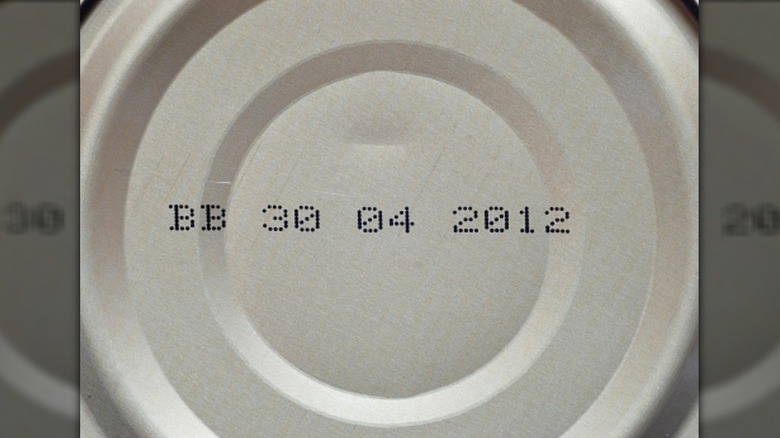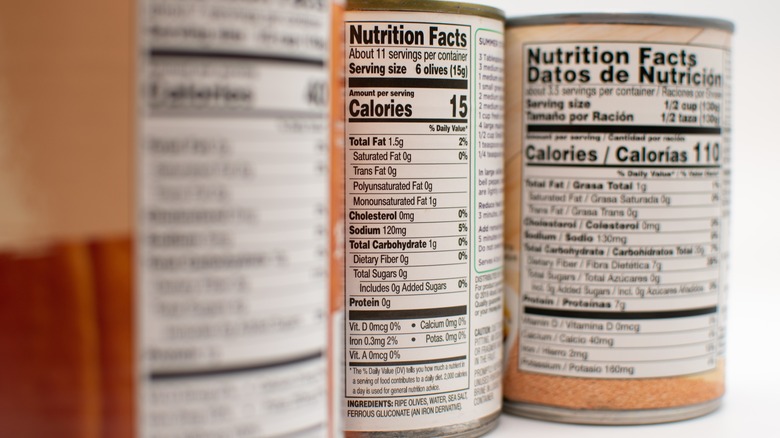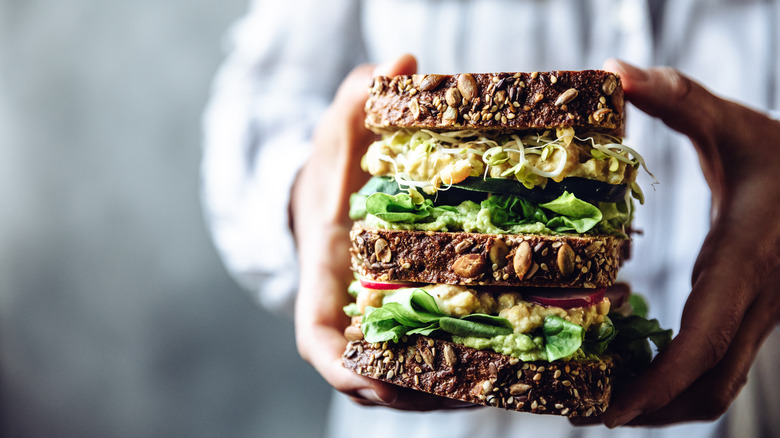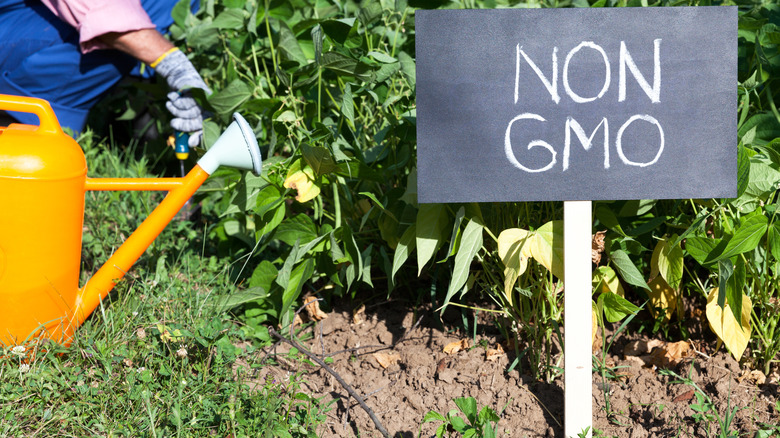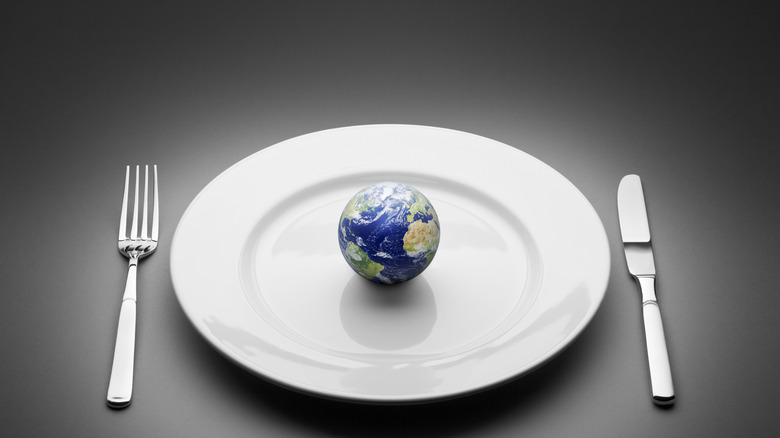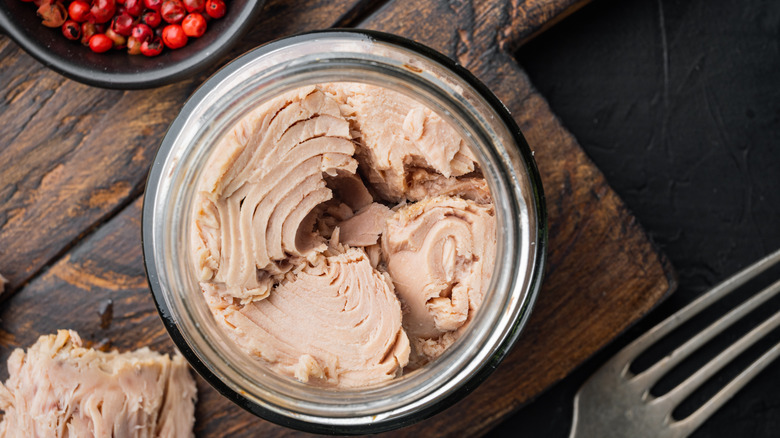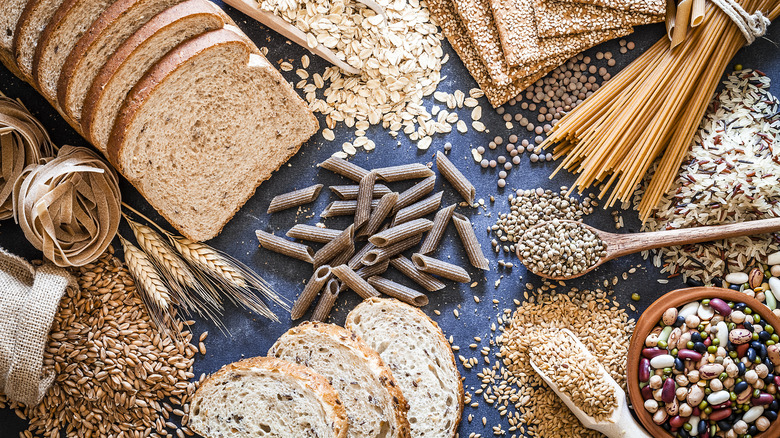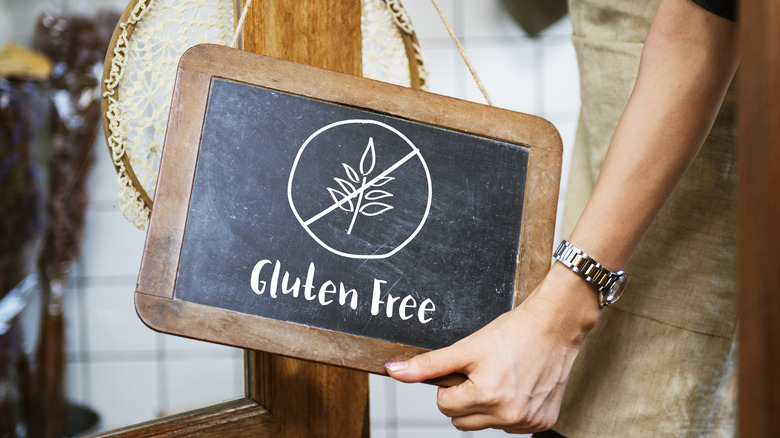14 Things To Look For On The Label When Buying Canned Foods
Canned food is the much-maligned recipient of a bad rap. Many view the humble canned good as a second-class grocery store citizen, the only option when your budget is tight and you need to feed yourself or your family. While subpar canned food is a definite possibility, these humble silver soldiers have come a long way since they were first produced in 1804 by French chef Nicolas Appert in response to his government's call for food preservation to support the French army in its global conquests.
The familiar ribbed can, reserved mainly for foods pasteurized before canning, is recognized and ubiquitous across the globe. But the key to making the most of that condensed soup, those beans, or the stray can of tuna? The label. Not all canned goods are created equal. Here are 14 things to look for on a canned food label (and how to get the most out of your canned goods).
Ingredients list
First stop? The ingredients list. It seems like a can of corn would include just corn, but don't be so sure. Even simple canned vegetables may have additional ingredients that are less than desirable. And when it comes to ready-to-eat canned foods like soup and pasta? Look very carefully to see what you're getting when you pop the top.
In general, the fewer the ingredients, the better. Look for whole, recognizable ingredients that you can pronounce — anything else might be an additive or chemical that's just not necessary. Other ingredients to look out for include thickeners like guar gum and xanthan gum; these are both technically natural ingredients (along with monosodium glutamate, a natural flavor booster that got loads of bad, slightly xenophobic press in the 1980s). Still, they aren't strictly necessary and only exist for textural purposes. In large amounts, guar gum and xanthan gum may be problematic in the digestive tract for some people, too.
The general category of natural and artificial flavors and colors is also something to watch out for. These are usually lab-created flavor or color additives. While most of these are harmless in small amounts, larger amounts in a diet that consists primarily of prepared foods have been linked to bone marrow damage in animals.
Sodium content
The U.S. Food and Drug Administration (FDA) recommends no more than 2,300 milligrams of salt per day (1 teaspoon) in the adult diet, but most adults in the U.S. consume far more than that (around 3,500 milligrams on average, according to the American Heart Association). Your body needs sodium to function, but it's important to pay careful attention to sneaky forms of salt that creep into your diet — especially in processed foods.
Salt has long been used as a preservative, but it also lifts the flavor of food and makes it taste more delicious. Additional salt is also sometimes used to hide sub-par ingredients or industrial preparations in canned food. Watching your sodium intake doesn't mean giving up convenience foods altogether. When reading the label, look for your favorites' low- or no-sodium versions, and add salt to taste at the table. This gives you far more control over your diet and allows you to take advantage of the convenience of canned food.
Added sugar
Sugar is tricky. We are biologically programmed to desire sugar as a source of energy and calories in our early lives; it's why breastmilk is sweet and why parents are advised to start feeding their children foods that have a natural sweetness to them (sweet potatoes, peas, apples) when it's time for solids. However, consumption of excess sugar is linked to myriad diseases and syndromes that include obesity, Type 2 diabetes, and heart disease. Some studies have found that even when controlling for obesity, a high-sugar diet is linked to early death.
It's time to grow up and check that canned food label for sugar. The Harvard Chan School of Public Health recommends no more than 24 grams of sugar per day (about 6 teaspoons) for most adult women and no more than 36 grams per day for men. Fortunately, labels are easy to read — they point out not only the grams of sugar but also the percent of a recommended daily diet. However, look for sneaky sugar labeled as fructose, glucose, or honey in everything from canned pasta to fruit cocktail. If you like a little sweetness in your life, aim for canned foods with a little bit of naturally occurring sugar; the "added sugar" column should be zero, even if there is sugar in the actual food.
BPA-free lining
Bisphenol A (BPA) is a chemical found in some can linings that can leach into food. This chemical is beyond harmful, as it doesn't simply affect you as you eat it (and then disappear once dinner is over). BPA works on the human body at the molecular level; it can damage fetuses in utero, affecting brain development and behavior. BPA accumulates in the tissues and the organs of the body, and it lingers in the soils of landfills and areas around the factories that produce it. These harms are well recognized, but the FDA has not banned the use of BPA in canned food; instead, manufacturers can use it but must seek approval for any packaging that includes the chemical.
There is no amount of BPA that is technically safe for consumption. When buying packaged food, look for those labeled BPA-free. A certification label awarded by various companies indicates a product with none of these harmful chemicals. These products do not usually cost more, and they are the best way to ensure the food you feed your family is safe.
Expiration, sell-by, and best-by date
If you don't regularly inventory your pantry, chances are good you've got a few questionable cans of years-old potatoes or O-shaped pasta tucked away. But there is a difference between sell-by and use-by dates, and even if that can is old, it might still be good.
The FDA has strict definitions of these sell-by and use-by labels, some of which are important to know. The sell-by date is the last day that a store is permitted to display the item; some discount grocery outlets may buy up these cans and sell them anyway, so it's good to know that a can with a long-past sell-by date is not necessarily bad. A use-by date is the last date that the can is at the peak of its quality (after the sell-by date). The use-by date is only a safety designation in the case of infant formula.
So what happens if you can't find any dates on your can? How do you know if an unlabeled can of food is no good? Generally, bulging, dents, or rust are clear indicators that it's time to toss it. Some people have no problem eating canned food that's a decade old. If you're worried (or squeamish), err on the side of caution and throw it out. This will help ensure you're consuming the product when it's at its best quality and safety.
Nutrition facts
Whether you are counting macros to get pumped or drop weight, or you just want to know if you are meeting the recommended daily requirements of calories, fats, carbohydrates, and proteins, the label on a can of food has you covered. These fall under the mandatory nutrient data category and include things like sugars, calcium, iron, and potassium (among other things).
To make these easier on consumers, each item appears in the same place (the back) and in the same order on every canned or packaged food label. You don't need to worry about hunting around for the same information on a can of peas and or a frozen bag of corn. Generally, data is given in grams and as a percentage of the recommended daily amount of each nutrient. Keep in mind that the recommended daily amount is based on a daily consumption of 2,000 calories. If you consume more or less of these calories or are on a specific diet, talk to your doctor about interpreting these numbers to meet your nutritional needs.
Serving size
We've all been guilty of this. That bag of Oreos isn't going to eat itself, and at the end of binge-watching our favorite show, we find ourselves with an empty package with only crumbs left to tell the tale. No problem, right? After all, there are only 160 calories in Oreos, so what's the big deal?
It's definitely not a big deal until you check the serving size: three cookies. If the entire Oreos package has 12 servings, and you absentmindedly eat the whole bag, you have just consumed 1,920 calories, including 84 grams of fat and 168 grams of sugar.
When serving canned foods, take out the measuring cup and follow the serving size to get the most accurate picture. Some cans of food (like tuna) are generally one serving, but canned pasta, soups, and vegetables contain more than one and should be divided. No one will fault you for eating more than your daily requirement of vegetables, but things get complicated once you start chowing down on prepared foods with added ingredients. Stick with the serving size on the can.
Organic certifications
Nowadays, it's not enough for a company to say it believes in all-natural foods. "All-natural" is a label with exactly zero teeth; even the FDA doesn't really tackle this label head-on, opting instead to say that a "natural" product has no artificial ingredients but not enforcing any company's labeling.
The only way to have a truly natural experience with your canned food is to look for a certified organic label. The U.S. Department of Agriculture (USDA) has four designations of organic foods: 100 percent organic, organic, made with organic ingredients, and specific organic ingredients. The USDA organic seal comes with a list of strict requirements that limit the use of chemical fertilizers for at least three years prior to growing. Growers may also not use any kind of chemical pest or weed control, and the ingredients list must not have any genetically modified foods. Organic food comes with a higher price tag, usually because farmers often experience lower yields, and the certification process is lengthy and expensive. However, if you want to cut costs but feed mostly organic, you can find varieties of your favorite foods that are at least made with some organic ingredients. Just check the label carefully.
Non-GMO verification
Genetically modified organisms (GMOs) have been manipulated in the lab for many reasons. Some agricultural scientists are trying to create seeds that resist pests, produce more, and don't require pollination. Livestock that eats genetically modified feed might grow larger meat areas (like chickens that grow breasts so large they cannot support their weight after a month). Generally speaking, conventionally grown meat, vegetables, and fruits have the same nutrition, but the lasting effects of genetic modification are still not well understood.
You don't need to eat strictly organic food to cut GMOs out of your diet, but it certainly helps. If you want to start slowly, educate yourself on the potential risks (and myths) about GMOs and look for the Non-GMO Project Verified seal. The seal is a butterfly and a checkmark, and it ensures that the can of food in your hand is made only of ingredients that were not altered or otherwise genetically changed.
Country of origin
As with all foods, canned foods are subject to recalls for safety issues. In 2023, the most dangerous foods recalled in the United States were fresh foods, and cans are generally recognized as safe. However, cans from manufacturers outside of the U.S. are not subject to the same strict standards that the FDA sets forth. These companies may not recognize a problem with their canned food or include an FDA-led recall if a safety issue occurs.
The FDA says that imported food must be safe, produced under sanitary conditions, and have clear labeling in English, but it does not enforce these standards for any company or check to see if they are met during manufacturing. The FDA does require imported foods to register their manufacturing facilities, and knowing the country of origin tells you something about the standards of processing used in that can of food. You can use your foods' country of origin to research that country's sustainability practices and general food safety standards.
Certifications
Every certification on a can of food adds to the price, but for consumers who can afford to be guided by their principles, it's easy to declare your values right along with your lunch. It's no secret that the world's oceans are struggling with pollution and overfishing, and the world's small farmers are being "swallowed" by industrial farms that can sell their wares at lower prices, undercutting the little guy. Even a proposed solution to overfishing — farmed fish — has resulted in the spread of disease among wild fish, poor conditions for fish, and less nutrition in the final product.
If you don't love to see how the world is trending, it's possible to make a difference, one can of food at a time. A fair-trade certification means farmers were paid a living wage for their labor. Wild-caught seafood (such as canned tuna and salmon) is certified using standards for allowable bycatch and limits on the amount of fish that protects the ocean. Pasture-raised meat animals have a better life and are better nutritionally than their conventionally farmed counterparts. Even replacing one of your regular canned items with a wild-caught or pasture-raised product makes a difference.
Fiber content
The Mayo Clinic recommends that healthy adults and children consume 14 grams of fiber per 1,000 calories. Fiber lowers cholesterol, promotes heart health, and keeps things regular, digestively speaking. But, the average consumption of fiber in the United States falls far short. The average person in the U.S. consumes just 15 grams of fiber daily.
Fiber need not be your diet's downfall, that elusive number that seems unattainable. Canned food is the perfect place to pack in some fiber. Fruits and veggies are naturally high in fiber, and canned food is convenient and affordable for most people. Canned beans are a great source of added fiber, as are canned spinach, green beans, and pumpkin. Some prepared foods that use alternative pastas (i.e., brown rice or lentil) are also great ways to bump up your fiber intake. Remember that the serving size matters here, too. Look for how much fiber is in each serving, and chow down accordingly.
Preservatives
Canned food that is pasteurized and canned under high heat, safely sealed against bacteria and the oxygen that feeds it, technically needs no other preservatives. Large manufacturers, ever protective of their bottom line and the potential economic disaster that a recall could trigger, may add more preservatives just to ensure that the food in the can remains fresh and safe for an extended period.
You don't need a chemistry degree to determine if preservatives are in your canned goods. Salt is a very common food preservative that is safe to eat in small amounts but can trigger health consequences when consumed to excess. On the other hand, sulfites are added to preserve color and flavor but can cause some asthma-like allergic reactions in some people. Benzoates have been linked to nervous system disorders, and sorbates and nitrates are linked to some general health concerns. If you are feeding children or other sensitive groups, such as older adults or people with illnesses or conditions that compromise their immune system, it's better to check the label of your canned food for preservatives.
Allergen information
Celiac sufferers the world over understand the particular challenge presented by gluten. Gluten is not listed as an ingredient on a can, and many ingredients (I'm looking at you, soy sauce) contain hidden gluten that can send someone to the hospital.
If you have food allergies, carefully check the label for allergen information. This includes what types of allergens may be present in the food and any potential for cross-contamination. This can get tricky for food allergens — for people severely allergic to peanuts, even the presence of peanuts in another part of the factory can be a serious cause for concern. Canned food labels include warnings about the potential exposure to allergens, and this information is critical. If you or a loved one have a life-threatening allergy, double-check the ingredients list and look carefully for any potential cross-contamination.
If you've carefully checked your labels and stockpiled enough canned food to last you through a major disaster but need to know how to make something delicious, here are more ways to make that boring can of beans better, or give your ramen a boost with canned goods – and important things to know about how long canned tuna lasts once it's opened.


